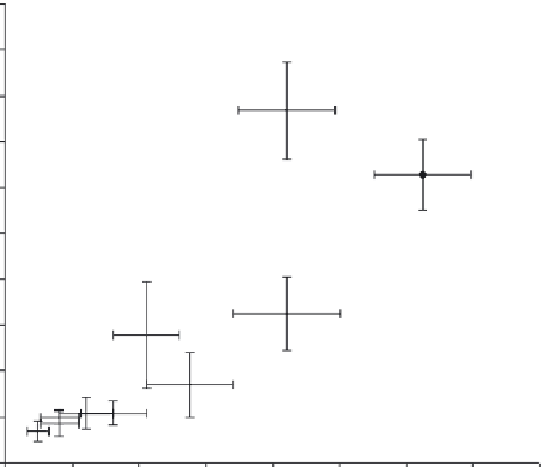Biology Reference
In-Depth Information
0.9
y
= 0.0224
x
- 0.1103
R
2
= 0.742
0.8
0.7
134
0.6
16
0.5
0.4
0.3
127
2028
417
0.2
1328
644
0.1
260
0.0
593
-0.1
0
10
15
20
25
30
35
40
5
Mean fecal pellets per h
FIGURE 11.3
Correlation of feeding rate (assessed by using production of fecal pellets) with incremental growth (mm) over 28
days in marine gastropods
Hydrobia ulvae
exposed to metal-rich sediments. Value indicated nearby each experi-
mental point is Cu concentration in sediment determined after extraction using HNO
3
in μg g
-1
, dry weight.
(After Shipp, E., Grant, A.,
Environ. Toxicol. Chem
., 25, 3246-3252, 2006.)
pattern was shown for the carp
Cyprinus carpio
. On the contrary, exposure of rainbow trout
to Cd induced a decrease of appetite, perhaps related to hypoactivity likewise described
in rainbow trout exposed to Al (McGeer et al. 2000 and literature quoted therein). On the
other hand, assimilation efficiency was not affected, and under experimental conditions of
ad libitum
feeding (a situation contrasting with natural conditions at least at certain periods
of the year when food is scarce), the growth rate was the same for all treatments. In embryos
of another freshwater fish, the grayling
Thymallus thymallus
, exposure to methylmercury for
the first 10 days of development, at concentrations that may be detected in eggs of carnivo-
rous fish from lakes receiving atmospheric depositions of mercury, induced a permanent
impairment of feeding behavior, still observable 3 years later (Fjeld et al. 1998). In young
stages of
Cyprinus carpio
exposed to metals (Cd, Cu), the malformations and disturbances of
swim bladder functions result in altered behavior, reduced locomotory and feeding activ-
ity, and in consequence—in reduced growth rate and viability of fish (Jezierska et al. 2009).
Baldwin et al. (2009) have developed a model that explicitly links sublethal reductions in
acetylcholinesterase activity to reductions in feeding behavior, food ration, growth, and size
at migration in wild salmon populations (
Oncorhynchus tshawytscha
). Studying the impact of
phenanthrene on gilthead seabream (
Sparus aurata
), Correia et al. (2007) concluded that the
overall changes in behavior might not necessarily be an indication of reduced fitness, at least
when the animals are monitored only over a short time. However, in the long term, lethargic
juveniles have a less optimal feeding efficiency and thus reduced growth rate parameters
(Correia et al. 2007 and literature quoted therein).













Search WWH ::

Custom Search